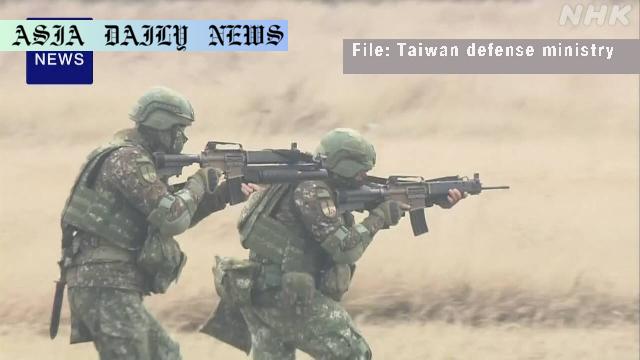Taiwan military drills: Taiwan begins its largest ever 10-day military drills as a direct response to rising Chinese tensions.
Taiwan has initiated its longest annual military drills, lasting 10 days.
Over 20,000 reservists are participating, including live-fire HIMARS training.
Air raid drills and evacuation exercises are planned in major cities.
The drills emphasize cooperation between military and civilians against ‘gray-zone’ threats from China.

Unprecedented Scale of Taiwan’s Military Exercises
Taiwan began its annual military drills, marking this year’s exercises as the longest and most elaborate yet, in a direct response to rising military pressure from China. Spanning 10 days, these exercises reflect the island’s growing need to strengthen its defense infrastructure amid regional tension. The 10-day timeframe is double the duration of last year’s drills, showcasing Taiwan’s heightened seriousness in countering possible military threats. This year’s maneuvers mobilize more than 20,000 reservists and include live-fire training using High Mobility Artillery Rocket Systems (HIMARS) acquired from the United States.
The drills focus on preparing against potential “gray zone” activities, a strategic form of aggression that includes incursions and intimidation tactics without direct combat engagement. This approach underscores Taiwan’s proactive stance in addressing increasingly multi-faceted threats while showcasing a cooperative defense strategy that integrates both military precision and civil action.
Civil Defense and Preparedness
Parallel to military maneuvers, Taiwan will hold large-scale urban drills in metropolitan areas like Taipei. These exercises simulate critical infrastructure assaults, including scenarios of missile strikes. Citizens are trained to evacuate efficiently and follow strict protocols to minimize potential casualties. By involving civilians in air raid and disaster preparedness, Taiwan’s government aims to instill a sense of shared responsibility and readiness among its population.
Integrating civilian involvement in large-scale defense operations is not without precedent. However, the scale and specific targeting of these drills reflect a strategic evolution. The focus isn’t merely on deterring aggression but fostering a robust and prompt response framework embedding citizens into the defense paradigm. Coordination with municipal authorities further strengthens urban response operations, giving Taiwan a better chance of withstanding major attacks.
International Military Support and Implications
The procurement and strategic deployment of HIMARS in these drills emphasize Taiwan’s reliance on its collaborative military alliance with the United States. HIMARS, known for its precision and effectiveness in combat, is a clear deterrent against escalation. Its inclusion in these drills underscores Taiwan’s intention to showcase its readiness against potential adversaries.
The implications of these drills echo far beyond Taiwan’s borders. Observers and stakeholders, including the United States, Japan, and other key allies, are closely monitoring the exercises. Efforts such as integrating reservists, advanced artillery use, and urban-based preparedness resonate as broader messages of determination. Taiwan continues to demonstrate its intent to safeguard sovereignty while unveiling a blueprint of resilience in the face of external threats.
Analyzing China’s Aggressive Posturing
China’s growing maritime and aerial incursions around Taiwan signal a significant increase in its militarized strategy. These “gray zone” operations aim to dismantle Taiwan’s morale and establish a normalized presence in contested zones. Meanwhile, Taiwan strategically responds by expanding and intensifying its military exercises while enhancing civilian oversight and engagement. The exercises not only challenge China’s encroachments but provide a blueprint for adaptive, resilient urban defense mechanisms during real-world scenarios.
Beijing’s response to these drills remains under tight observation. The global geopolitical narrative surrounding Taiwan’s sovereignty continues to evolve as the stakes rise in the Indo-Pacific region. Taiwan’s continuous push to refine and showcase its defense capabilities serves as a compelling symbol of resistance and foresight in a volatile security environment.
Commentary
Taiwan’s Assertive Stand Amid Pressures
Taiwan’s latest military drills signify a pivotal moment in its approach to regional security. The decision to extend the exercises to 10 days and incorporate intensive training for both reservists and civilian sectors reflects a strategic mastery of preparedness. In an era defined by ambiguous threats and gray zone tactics, Taiwan’s proactive measures demonstrate its determination to safeguard its sovereignty and way of life. These efforts are essential as they not only prepare the nation for military conflict but also aim to unify the citizen and defense forces into a comprehensive and cooperative deterrence strategy.
Reinforcing Civilian Syndication in Defense
What stands out distinctly in Taiwan’s approach is the civilian engagement. By preparing its population for scenarios like air raids and infrastructure assaults, Taiwan is fostering a culture of resilience and shared responsibility, which will be pivotal in times of crisis. Beyond the practical benefit, the inclusion of citizens in these drills also arguably boosts societal morale. Knowing that both the government and citizens are actively taking measures against possible threats brings confidence and cohesion in uncertain times—a lesson that holds value beyond Taiwan’s borders.
An Evolving Geopolitical Narrative
Taiwan’s military preparedness is not just a response to immediate pressures but a projection of strategic signaling to an international audience. The exercises showcase Taiwan’s resolve to key allies like the United States and Japan, signaling that any aggression by China would come at a significant cost. Furthermore, this narrative reaffirms the importance of democratic resilience in the region. These drills, though domestic, are a profound reminder to the global community of the challenges faced by smaller nations that stand firm in the shadows of dominant powers.
In conclusion, Taiwan’s military exercises underline its unwavering commitment to defend its sovereignty and well-being. From advanced technology implementation to grassroots civilian engagement, Taiwan is showing a well-rounded, adaptive approach to modern threats. This determined and multifaceted strategy solidifies Taiwan’s position as a robust democratic state prepared for an uncertain future.


